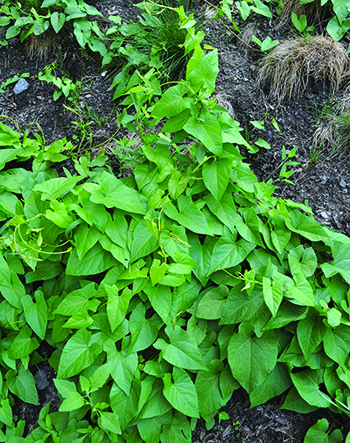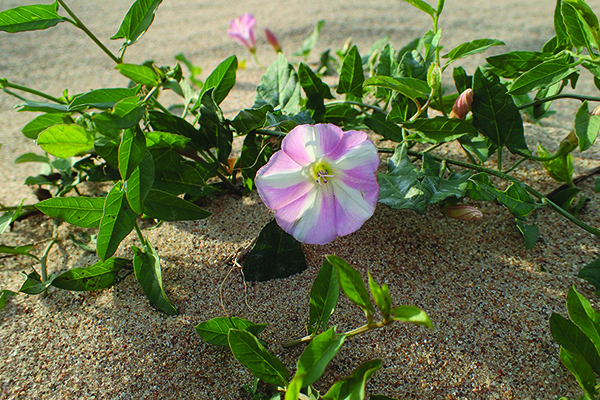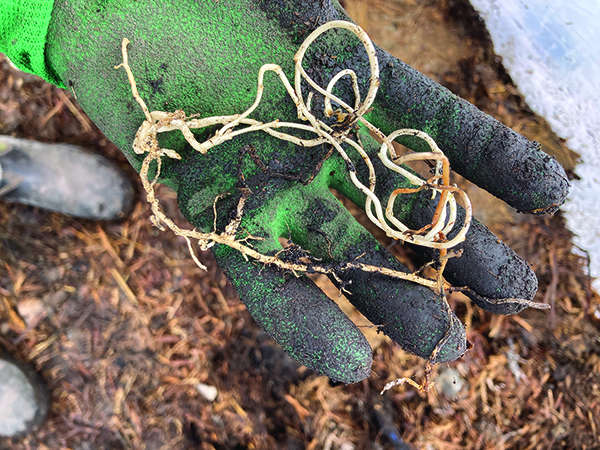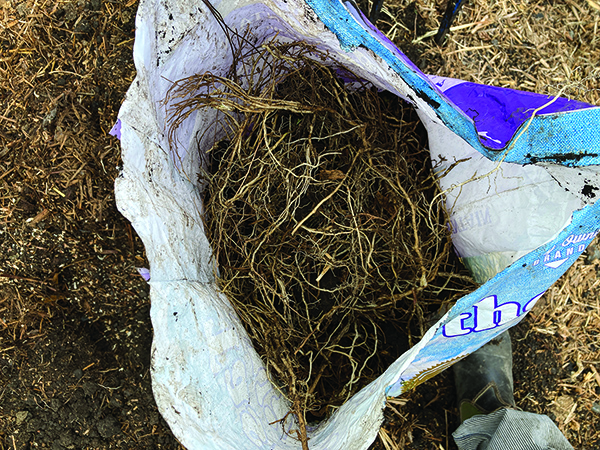Last summer during the drought and never-ending heat dome in the Pacific Northwest, I watched field bindweed on my vegetable farm go from spotty to ubiquitous. It went from a nuisance in a few spots that I kept an eye on, to a presence that haunted my days and nights.
I went on a mission to understand field bindweed, why it suddenly exploded at my farm, and what I could do to manage it. I found a lot of conflicting information from state agriculture extension agencies. I will do my best to make clear what management strategies work. I will also share tips from GFM readers and strategies I am experimenting with on my farm.
There are several stories about how and when this Eurasian plant was introduced to North America. Perhaps as an ornamental or perhaps, in a depressingly short-sighted choice, as an agricultural cover crop. Either way, by 1900 field bindweed was considered a menace by the USDA and is now found in most of the United States and Canada.
 This shows how bindweed can overgrow other plants or whatever is in it’s way. Photo by New York State IPM program at Cornell University.
This shows how bindweed can overgrow other plants or whatever is in it’s way. Photo by New York State IPM program at Cornell University.
Field bindweed, Convolvulus arvensis, is known by many common names—morning glory, creeping jenny, bellbine, sheepbine, and cornbind. It can be confused with the annual ornamental morning glory, distinguished by much larger flowers and leaves. It is also confused with hedge bindweed, prostrate knotweed, and sharpoint fluvellin. Field bindweed is identified by its small arrow-shaped leaves, white or pink flower, and its admirable will to live.
Field bindweed is tough to impossible to kill because it utilizes every trick in the botanical book. I don’t think a hardier weed could be imagined or designed. Let’s appreciate how incredible this plant is for one moment (pause) and resist the urge to despair (chin up). Understanding why field bindweed is so tough to control helps us to take it easy on ourselves, to understand conditions favorable to growth and regrowth, and to focus our control strategies.
Use many small hammers
Oregon State University researchers Jessica Green and Marcelo Moretti have tested many treatments in the noble pursuit of organic field bindweed control (they have an e-Organic YouTube video on the topic if you want to find it). Green’s best advice is to use Integrated Pest Management (IPM) or “many small hammers” to manage bindweed. Put another way, field bindweed’s many survival strategies call for several management strategies. Not a buckshot approach which is diffuse, but what Green calls a “toolbox approach.”
Make sure you bring in only clean compost, amendments, and animal feed. Also look every gift plant in the mouth. Those raspberries or irises from the neighbor could bring bindweed. If you do have field bindweed, clean your tools and implements between fields or beds to avoid spreading it.
Green says the best way to propagate field bindweed is to chop it into pieces and scatter it through moist, fluffy soil. If you till, she says, till deeply when the soil is dry. Tilling field bindweed works only if the plant is disturbed and desiccated.
 Bindweed showing characteristic leaf shape and pink-to-white flowers. Flowers produce seeds that may be viable for up to 60 years. Photo by Krzysztof Ziarnek.
Bindweed showing characteristic leaf shape and pink-to-white flowers. Flowers produce seeds that may be viable for up to 60 years. Photo by Krzysztof Ziarnek.
If tilling is part of your farm practices, Green and many ag extension publications recommend tilling deeply every two weeks for three years in order to deplete field bindweed of its deep, stored energy. Again, tilling must be done in dry soil in order to prevent plant parts from re-growing. Of course, tilling every two weeks is only an option in walkways rather than in your growing beds, but the same timeline applies for in-row cultivation. Remember that the plant is most susceptible within the first four weeks after germination.
Moretti also studied the efficacy of controlling field bindweed with a rotary brush weeder in blueberry fields. Tractor-mounted rotary brush weeders spin many “fingers” that look like weedeater string. The implement can be driven at 0.5 miles per hour and cuts bindweed off at the surface. It was developed for weed control under vines in vineyards, and may be a better option for no-till and perennial plant systems, but the equipment is expensive.
Shade and competition
Bindweed’s biggest weakness is shade. Covering bindweed with landscape fabric, opaque tarps, or deep, heavy mulch, will reduce biomass and (fingers crossed) eventually kill the plant. Dense cover cropping with alfalfa and cereal grains has been shown to reduce bindweed through shading and competition. Green recommends the field bindweed “five year knock out plan” developed by farmer and researcher Fred Kirschenmann, which combines cover cropping and tillage. (See diagram.)
Farmer Jeff Negron of The Growing Seed in Long Island, New York, had success using Peruvian huacatay, aka black mint, as a cover crop and knocked back the bindweed in a few years. He suspects planting hemp could do the same due to similarly dense, fibrous root systems.
Shade and competition are important tools in the toolbox. Yet, bindweed will use its own toolbox of survival strategies to overcome them. It escapes tarps and mulch with lateral growth away from the shade and leverages cover crops by climbing them to reach the sun. This is why many hammers, IPM, is required.
Biocontrol pests, steam and electrical weeding
Moretti also tested steam weeding in blueberry fields. Water was heated to 250 degrees and sprayed on plants. Typically, it took one or two applications to kill the bindweed. Downsides are the cost of the equipment and high water and fuel use. Moretti said steam weeding can work in small-scale production. “Some units are connected to a garden hose and could treat small field or hoop houses,” he wrote. The technology is not yet ready at scales using tractors because vibration, dust, and exposure to hot and cold conditions affect the machine’s performance, he said.
Moretti is also starting to trial electric weeders, which kill plants thermally. “I have only treated bindweed with electricity occasionally,” he wrote. “I noticed that it is effective in killing top portions, and regrowth is very delayed after a single treatment.” He is currently researching electric weeders and wrote, “I expect it will be a very useful tool against bindweed and other non-woody perennial weeds.” However, the technology is still forthcoming, and expensive as it is not widely available in the US yet.
 Bindweed roots that the author pulled over the winter when the plant was dormant. Fragments of roots as short as one inch can form new plants. Photo courtesy of the author.
Bindweed roots that the author pulled over the winter when the plant was dormant. Fragments of roots as short as one inch can form new plants. Photo courtesy of the author.
Green has focused field bindweed studies on the two approved biocontrol insects. Biocontrol agents are extensively studied to make sure they target the weed and not other crops or native plants.
One is the bindweed mite, Aceria malherbae, which damages bindweed creating galls, curling, and discoloration to help keep the weed at bay. Mites can be spread throughout an area by mowing infected areas or by collecting infected bindweed and wrapping it around healthy bindweed. It can take a few years to establish a population of mites, but they overwinter and reemerge in July.
The downside to the mite is that they do better in dry, less disturbed, non-irrigated areas such as pasture. The mites are not effective in irrigated areas. When field bindweed has ample water it is able to fight the mite off.
Green is also studying the bindweed moth, Tyta luctuosa, whose caterpillars voraciously feed on bindweed leaves. In the lab, a single caterpillar was found to reduce 10 grams of bindweed 64 percent in a week. If you extrapolate this to 100 grams, about the size of a medium tomato, you can imagine 10 tiny caterpillars reducing that tomato by half in a week. Green’s PhD research into Tyta luctuosa at OSU is promising and ongoing.
Growers interested in giving biocontrols a try should first make sure they have true field bindweed, Convolvulus arvensis, as the biocontrols won’t work on the look-a-likes. Then get in touch with the state ag agency or the Animal and Plant Health Inspection Service (APHIS) through a local USDA office.
Control experiments on my farm
Last year one of my co-workers and I pulled enough bindweed from one bed to fill the back of a Ford Ranger — twice. We didn’t even try to get the roots as we freed the broccoli from the stranglehold. I marveled at the biomass and tried to crack jokes at the demoralizing task. “I just wish we could kill bindweed with all this bindweed,” I said. My co-worker Brian added, “Killing bindweed with bindweed is the ultimate dream!”
It was about 100 degrees (desiccation weather), so we decided pile the green bindweed in the walkways and flail mow it to see if it could make effective mulch. The flakes of straw we put down surely did not. We found that deep, green mulch that blocks light really kept the bindweed at bay.
We collected medium-dry grass clippings from a nearby church camp that doesn’t spray herbicides and put them in the walkways too with the same result. We basically found that the greenish mulch makes a mat that blocks light, which is the only real weakness bindweed has.
This spring I’ve been peeling back the mulch layers and finding that while the bindweed is not gone, there is definitely less of it. I have been able to quickly hula-hoe anything that pokes up — a massive improvement over last year. I have also noticed the areas treated with the flailed bindweed have much less than the areas treated with the grass clippings. Maybe Brian’s ultimate dream will come true.

Besides greenish mulch, I experimented with grazing bindweed. My daughter’s rabbit, Bunny Jane, slurps bindweed like noodles, and we move her around the edges of the fields in a mobile cage. Our two horses are effective grazers on the edges of the field, but Green warns of rare problems with horses eating bindweed. Sheep, goats, and cattle eat it without problems.
I was also able to experiment with biocontrols. With help from my local county weed control, I was able to get bindweed mites from APHIS last August. They haven’t been here long, but so far, I am impressed with the damage the mites have done on the edges of the field. I’m looking forward to seeing what they do this year.
Finally, I tried just chilling out about the bindweed a little. I grow primarily salad mix. Bindweed is very easy to spot when we’re sorting lettuce, it isn’t poisonous to eat, and a dense stand of baby greens competes. I don’t want it taking over the farm, but I can’t spend all my time pulling or digging it either. I am focused on the more passive approaches to controlling bindweed on the edges of my fields and in my walkways. I’ve ordered huacatay seed so I can try Jeff Negron’s method of shading and outcompeting it on the field edges.
So far 2022 is much wetter than 2021 so I’m hopeful the field bindweed has less of an advantage this year. The chickweed would like to inform you, however, it is doing great with all this rain. At least it is an annual.
Nella Mae’s bindweed control cocktail
It is just semantics, but I think it is more fun to attempt something as demoralizing as bindweed control with a “cocktail approach” rather than a “toolbox” or “many hammers” approach. So, here’s my Bindweed Control Cocktail recipe.
1. Tons of “green” mulch. Mulch all walkways in bindweed areas with “green” mulch like flailed green (not dry) weeds or clean grass clippings at least four inches deep. Keep reapplying mulch through the season.
2. A dash of hoeing in the growing area. Regularly scuffle or hula-hoe bindweed areas in beds once or twice per week as soon as you can see them popping up.
3. A pinch of bindweed-eating critters. Mites, bunnies, horses—whatever you can get your hands on, try to get some grazers on the edges for some passive control.
4. For the garnish, ring fields with huacatay, hemp, alfalfa or other cover crops that can outcompete the field bindweed on the edges.
Each of the control methods mentioned must be accompanied by constant vigilance, long-term application, and correct timing. Constant vigilance and long-term application of control methods are key because of the persistence of bindweed. As Green said, “Bindweed is a founding member of the ‘World’s 50 Worst Weeds’ list. It is ubiquitous in organic and conventional agriculture.”
You can save time and effort by understanding field bindweed and applying controls at the right times. Don’t till bindweed if the soil is wet. Summer weeding may be more effective than spring weeding according to some of Moretti’s steam and brush weeding results. However, seeds can be viable within 10 days of flowering, so personally, I don’t intend to let any bindweed go to flower.
As with everything in farming, it follows that each farmer has to find the toolbox or cocktail of control methods that work best for his and her practices and farm.
In conclusion, I don’t want to feel like I’m in a fight every day on the farm. Bindweed can make you feel that way. I’m a plant nerd at heart, and I try to admire the bugger for its tenacity. Maybe those of us in small-scale agriculture need to take bindweed on as a mascot. Given the weather, climate change, the weeds, the pests, fickleness of customers, we could probably all use a little more bindweed energy to adapt to all the risks and uncertainty we face. Let us go forth in the spirit of Convolvulus arvensis.
Nella Mae Parks farms on her family place in Cove, Oregon. She just completed her eighth season home, growing vegetables for her on-farm farmstand, the farmers market, and wholesale outlets in the region.
.png)

